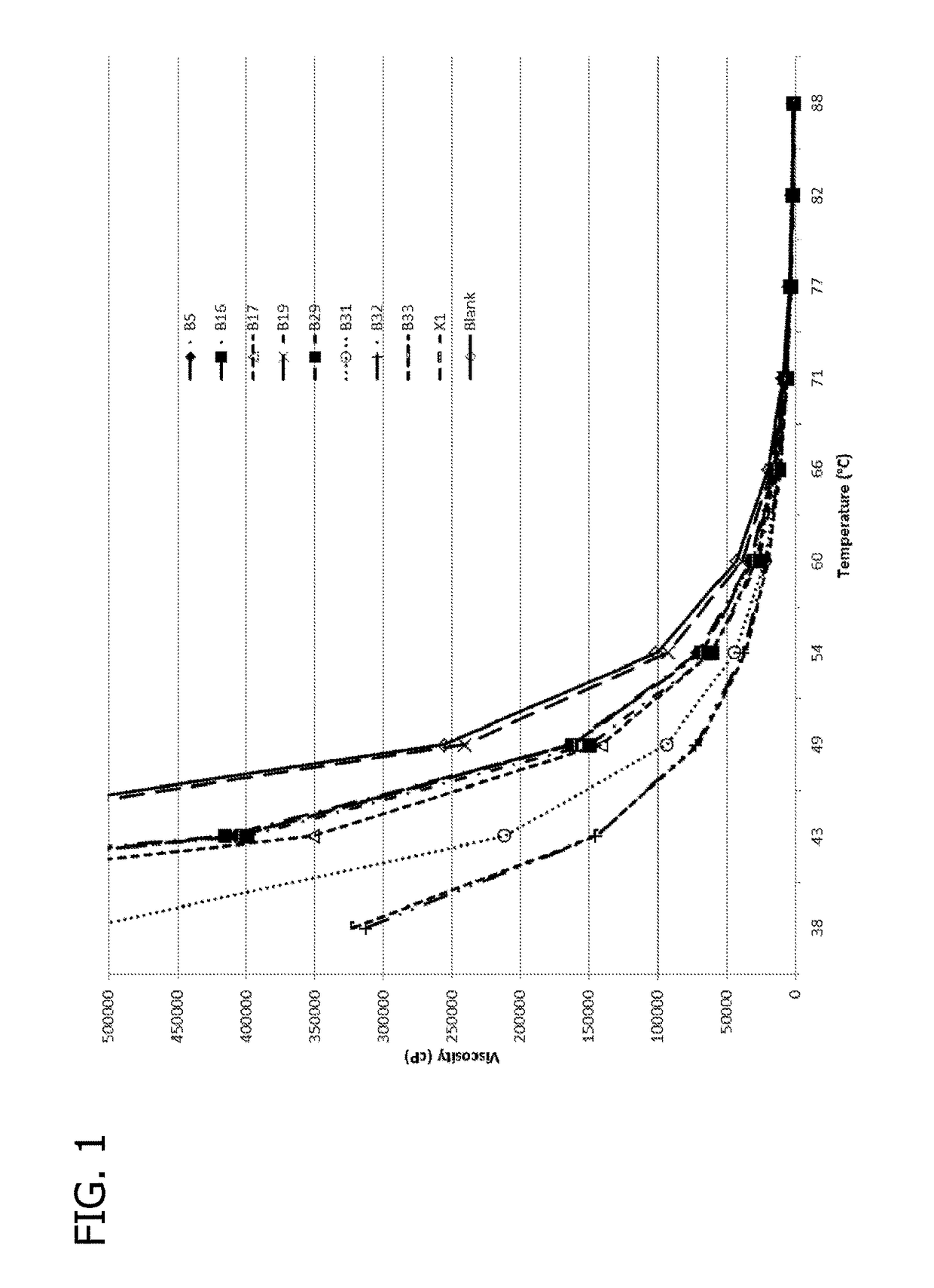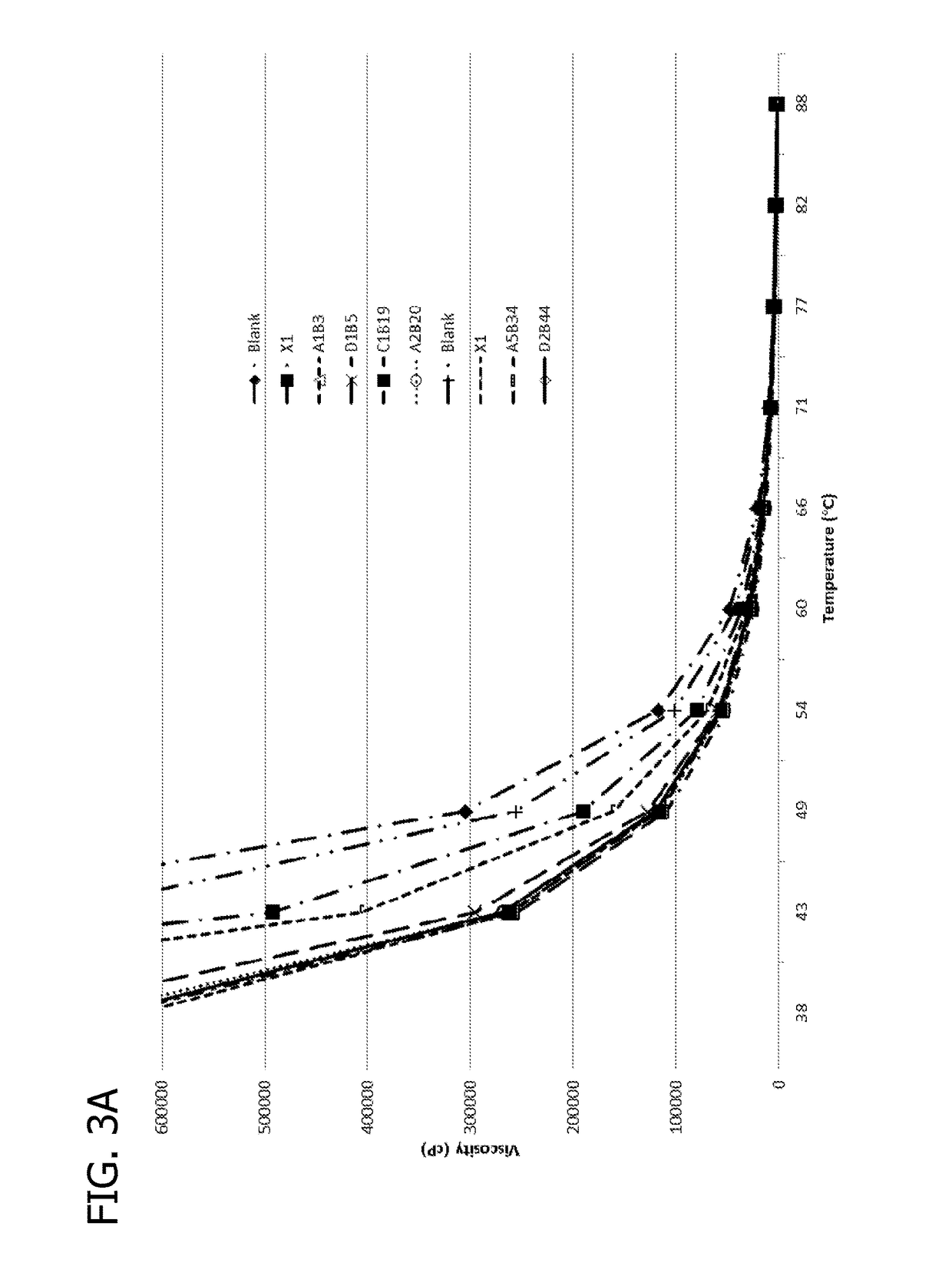Heavy oil rheology modifiers for flow improvement during production and transportation operations
a technology of rheology modifier and heavy oil, which is applied in the direction of pipeline system, gas/liquid distribution and storage, chemical apparatus and processes, etc., can solve the problems of difficult pipeline flow, difficult to improve the flow many challenges in the production, transportation and refining of heavy and extra-heavy crude oil, so as to improve the production and transportation of crude oil and reduce the viscosity of crude oil.
- Summary
- Abstract
- Description
- Claims
- Application Information
AI Technical Summary
Benefits of technology
Problems solved by technology
Method used
Image
Examples
example 1
d Viscosity Measurements
[0104]Viscosity measurements were performed at a field site where heavy and extra-heavy crude oils are produced using electrical submersible pumps (ESP). The formulations of the oil-soluble compositions and blends tested are listed in Tables 1 and 2, respectively. General production characteristics of the stations at the field site are listed in Table 3.
TABLE 3General production characteristics.Parameter / Oil WaterCrude TreatmentStation(BOD)(BWD)API gravityBS&W13,63217,83714.40.39262,762324,45315.20.33350,699332,43212.50.37463,00050,0009.00.60Total117,093674,722
[0105]Production fluid was obtained and drained of free water. Basic sediment and water (BS&W) was measured to be in the range of 10-14%. Crude oil was pre-heated in a water bath at 82° C. for 1-2 hours (generally 1 hour). The oil was homogenized; a sample (550 mL) was poured into six low-form glass beakers, and was left for 15 minutes to eliminate any foam that might have formed on the surface. The bea...
example 2
Tests without Diluent
[0111]Heating and cooling profiles of blanks, where none of the oil-soluble compositions were added, were obtained as follows: free water was drained and oil was homogenized with the help of a glass rod. The oil was preheated to 40° C. and 400 g was poured in a Schott bottle. The sample in the Schott bottle was preheated to 40° C. for 30 minutes and put in a mechanical shaker at 140 spm for 30 minutes. The oil was then transferred to glass beakers. The beakers were placed in a water bath at 40° C. for 30 minutes and were covered with aluminum foil. If any foam or bubbles were observed on the surface, they were broken with a spatula.
[0112]A sample was removed from the water bath and placed in a DV-II Pro Brookfield viscometer to measure the viscosity. The spindle, S63 or S64, and spinning rate used were selected to obtain a torque value between 15% and 85%, preferably between 50% and 85%. After the measurement, the sample was placed in a water bath at 50° C. for ...
example 3
Tests with Diluent
[0115]Following the initial tests in Example 2, and determining the best flow improvers, additional tests were carried out with the addition of 3% diluent (naphtha). The testing procedure followed the general methods described in Example 2 but with the following modifications.
[0116]The corresponding amount of flow improver (250 ppm of actives) was added to scintillation flasks containing a known amount of naphtha and was pre-heated in an oven at 50° C. The bottles containing the oil sample were placed in a water bath at 40° C. After 30 minutes, the oil-soluble composition dissolved in the diluent was poured on the surface of the oil and the bottles were gently shaken by hand. The bottles were then placed in a mechanical shaker at 140 spm. After 30 minutes, they were put back in the water bath at 40° C. After 10 minutes, the oil was poured into glass beakers. The beakers were placed in a water bath at 40° C. for 20 minutes. They were then covered with aluminum foil....
PUM
 Login to View More
Login to View More Abstract
Description
Claims
Application Information
 Login to View More
Login to View More - R&D
- Intellectual Property
- Life Sciences
- Materials
- Tech Scout
- Unparalleled Data Quality
- Higher Quality Content
- 60% Fewer Hallucinations
Browse by: Latest US Patents, China's latest patents, Technical Efficacy Thesaurus, Application Domain, Technology Topic, Popular Technical Reports.
© 2025 PatSnap. All rights reserved.Legal|Privacy policy|Modern Slavery Act Transparency Statement|Sitemap|About US| Contact US: help@patsnap.com



